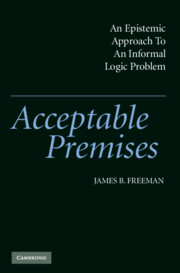Book contents
- Frontmatter
- Contents
- Preface
- Acknowledgments
- PART 1 ACCEPTABILITY: DIALECTICAL AND EPISTEMOLOGICAL COSIDERATIONS
- PART 2 STATEMENTS, BELIEF-GENERATING MECHANISMS, AND PRESUMPTIVE RELIABILITY
- 5 What Types of Statements Are There?
- 6 Necessary Statements and A Priori Intuition
- 7 Descriptions and Their Belief-Generating Mechanisms
- 8 Interpretations and Their Modes of Intuition
- 9 Evaluations and the Moral Faculties
- 10 Taking One's Word: The Interpersonal Belief-Generating Mechanism
- PART 3 PRACTICE AND PERSPECTIVE
- Notes
- References
- Index
9 - Evaluations and the Moral Faculties
Published online by Cambridge University Press: 02 December 2009
- Frontmatter
- Contents
- Preface
- Acknowledgments
- PART 1 ACCEPTABILITY: DIALECTICAL AND EPISTEMOLOGICAL COSIDERATIONS
- PART 2 STATEMENTS, BELIEF-GENERATING MECHANISMS, AND PRESUMPTIVE RELIABILITY
- 5 What Types of Statements Are There?
- 6 Necessary Statements and A Priori Intuition
- 7 Descriptions and Their Belief-Generating Mechanisms
- 8 Interpretations and Their Modes of Intuition
- 9 Evaluations and the Moral Faculties
- 10 Taking One's Word: The Interpersonal Belief-Generating Mechanism
- PART 3 PRACTICE AND PERSPECTIVE
- Notes
- References
- Index
Summary
In this chapter, we follow the same overall procedure as in the last three. We first identify the types of evaluations or value judgments one may distinguish, presenting a standard philosophical account. We inquire for each of these types whether some mechanism generates such evaluations as basic beliefs and whether there is a presumption for its reliability in this employment. We see two mechanisms, moral sense and moral intuition, involved in generating basic beliefs expressing value judgments. Before asking about their presumptive reliability, we discuss how they are related and what types of evaluations may be basic.
THE STANDARD ACCOUNT OF TYPES OF EVALUATIONS
There is a standard threefold division of value judgments into judgments of nonmoral value, of moral obligation, and of moral value. Following Frankena, we call judgments of moral obligation deontic judgments and judgments of moral value aretaic judgments (1973, p. 10). Similarly, we may speak of deontic value and aretaic value. “Right” is the paradigm term for ascribing deontic value and “virtuous” for aretaic value. Deontic value is a property of acts, whereas aretaic value is a property of the motives and characters from which acts proceed.
“Good” in one sense is the paradigm ascription of nonmoral value. “Good” and “bad,” however, have several senses. Some things are morally good or morally bad. As Ross points out, moral goodness belongs to actions “in virtue of the motives that they proceed from” (1930, p. 156). Moral goodness and moral badness then are terms ascribing aretaic value.
- Type
- Chapter
- Information
- Acceptable PremisesAn Epistemic Approach to an Informal Logic Problem, pp. 218 - 280Publisher: Cambridge University PressPrint publication year: 2004



